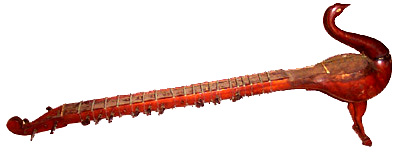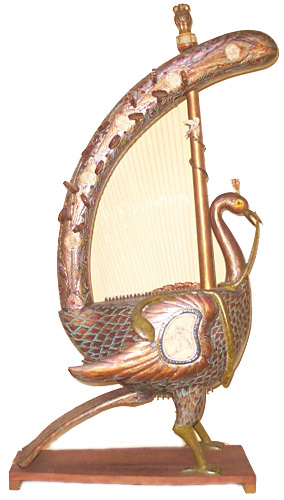. |
Jalatarangam
Jalatarangam meaning
"water waves" consists of 18 porcelain cups of distinct sonorousness arranged in a
semicircle before the performer. The empty cups give notes of different pitch. Water is poured
into the cups and played.
|

|
| 
|
Balasaraswati
This is called Tavus
in the North. In shape and construction, it is the same as the Sitar, but has a peacock
like resonator and the instrument is played with a bow. The frets are movable. The body and
the stem are painted like that of the peacock. Underneath the frets there are a number of
sympathetic strings. The small ivory pegs round which these sympathetic strings pass before
reaching the tuning pegs are seen as white dots on the finger-board in the figure. The small
tuning pegs for these sympathetic strings are seen on the side of the stem. There is a
parchment belly over which an ivory bridge is placed. The instrument has a soft mellow tone.
The instrument is held in an oblique position - the neck resting on the left shoulder and the
legs of the peacock resting on the ground and played. The neck of the peacock is easily
detachable from the body. The instrument is finely ornamented with ivory. On account of
the peacock-like resonator, the instrument is also called Mayuri, Peacock sitar and
Peacock fiddle.
|
| S-shaped Horns
They consist of four pieces while others
have six pieces. The S-shaped horns, like the Kombu, which is crescent shaped are used
in temple processions, receptions and public amusements. |

|
 |
Mayil
Yazh
The ancient Yazh described
in Tamil classical literature has disappeared from Southern India long ago. Its modern
representative is the Mayil Yazh, a stringed instrument, which resembles peacock. |
|

|
|